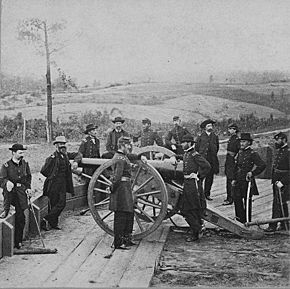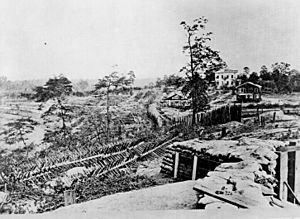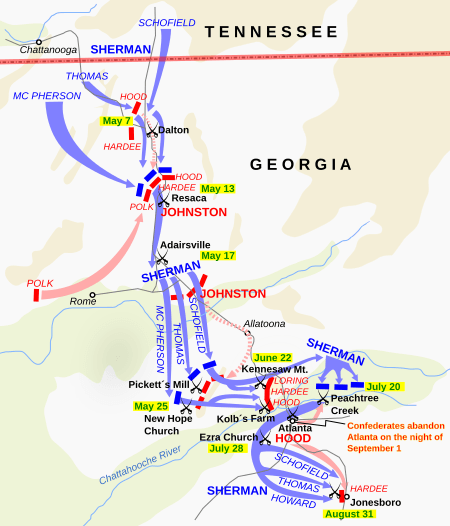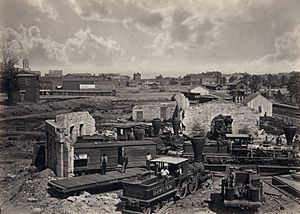Atlanta campaign facts for kids
Quick facts for kids Atlanta campaign |
|||||||
|---|---|---|---|---|---|---|---|
| Part of the American Civil War | |||||||
 Union Maj. Gen. William T. Sherman and his staff in the trenches outside of Atlanta |
|||||||
|
|||||||
| Belligerents | |||||||
| Commanders and leaders | |||||||
| Units involved | |||||||
|
Military Division of the Mississippi: |
Army of Tennessee | ||||||
| Strength | |||||||
| 112,819 | Beginning- 60,000 Infantry, 11,000 cavalry, 7,000 Artillery | ||||||
| Casualties and losses | |||||||
| 31,687; (4,423 killed, 22,822 wounded, 4,442 missing/captured) |
34,979; (3,044 killed, 18,952 wounded, 12,983 missing/captured) |
||||||
The Atlanta campaign was a major series of battles during the American Civil War. It took place in northwest Georgia and around the city of Atlanta in the summer of 1864. Union General William Tecumseh Sherman led his army from Chattanooga, Tennessee, into Georgia. He faced the Confederate General Joseph E. Johnston.
Johnston's army, called the Army of Tennessee, slowly retreated towards Atlanta. Sherman kept trying to go around Johnston's army, forcing them to move back. In July, the Confederate president, Jefferson Davis, replaced Johnston with a more aggressive general, John Bell Hood. Hood immediately started attacking Sherman's army head-on. These attacks were very costly for the Confederates. Eventually, Hood's army was trapped in Atlanta. The city fell on September 2, 1864. This victory was a big step towards the end of the war and led to Sherman's March to the Sea.
Contents
Background to the Campaign
Why the Armies Fought in Georgia
The Atlanta campaign happened after the Union army won the Battles for Chattanooga in November 1863. Chattanooga was a very important city, known as the "Gateway to the South." Capturing it opened the way for the Union to push deeper into Confederate territory.
After his success, General Ulysses S. Grant became the top general for all Union armies. He put his trusted friend, William T. Sherman, in charge of the Western armies. Grant's plan was to attack the Confederacy from many different directions at once. While Grant and other generals fought in Virginia against Robert E. Lee, Sherman's job was to defeat Johnston's army, capture Atlanta, and then move through Georgia. Atlanta was a vital city for the Confederacy because it was a major railroad hub and industrial center.
The Armies and Their Leaders
Union Forces
At the start of the campaign, General Sherman's army was called the Military Division of the Mississippi. It was made up of three main armies:
- The Army of the Tennessee led by Maj. Gen. James B. McPherson.
- The Army of Ohio led by Maj. Gen. John M. Schofield.
- The Army of the Cumberland led by Maj. Gen. George H. Thomas.
| Main Union Commanders |
|---|
|
Sherman's army started with about 98,500 soldiers. By June, with more troops joining, his strength grew to 112,000.
Confederate Forces
The Confederate army opposing Sherman was the Army of Tennessee. It was first led by General Joseph E. Johnston. Later in the campaign, Lt. Gen. John Bell Hood took command. This army had about 50,000 soldiers at the beginning.
| Main Confederate Commanders |
|---|
|
General Johnston was known for being careful. He often pulled his army back instead of fighting big battles. In Georgia, he faced the very aggressive Sherman. Johnston's army often dug into strong defensive positions. Sherman usually avoided attacking these head-on. Instead, he would try to march around Johnston's defenses, especially on the left side. This forced Johnston to retreat to a new position. Both armies used the railroads to bring in supplies. Johnston's supply lines got shorter as he moved closer to Atlanta, while Sherman's got longer.
Key Battles of the Campaign
Sherman vs. Johnston: The Early Phase
Rocky Face Ridge (May 7–13, 1864)
Johnston's army was dug in on a long mountain called Rocky Face Ridge. Sherman sent two groups to attack the front. He sent a third group, led by General McPherson, to go around the right side through Snake Creek Gap. McPherson's group reached Resaca, Georgia, but found Confederates dug in there. McPherson pulled back. Sherman then decided to move most of his army to join McPherson and attack Resaca. When Johnston saw Sherman moving, he pulled his army back to Resaca.
Resaca (May 13–15)
Union troops tested the Confederate lines around Resaca. Heavy fighting happened on May 14. The Union attacks were mostly pushed back. On May 15, the battle continued. Sherman sent a force across the Oostanaula River to cut Johnston's railroad supply line. Johnston could not stop this move, so he had to retreat again.
Adairsville (May 17)
Johnston's army kept retreating south, with Sherman chasing them. Johnston hoped to find a good place to defend near Adairsville, but the valley was too wide. So, he pulled his army back again.
New Hope Church (May 25–26)
After Johnston retreated to Allatoona Pass, Sherman decided it would be too costly to attack there. He tried to go around Johnston's left side towards Dallas. Johnston guessed Sherman's move and met the Union forces at New Hope Church. Sherman thought Johnston only had a small force and ordered an attack. This attack was a disaster for the Union. Both sides then dug in.
Dallas (May 26 – June 1)
Sherman's army kept trying to find a weak spot in the Confederate line. On May 28, the Confederates attacked the Union lines but were pushed back with many losses. Sherman continued to look for a way around Johnston's defenses. On June 1, Union cavalry captured Allatoona Pass, which had a railroad. This meant Sherman could get supplies by train. Sherman left his lines at Dallas on June 5 and moved towards the railroad. This forced Johnston to follow.
Pickett's Mill (May 27)
After the Union loss at New Hope Church, Sherman ordered another attack on Johnston's right side. But the Confederates were ready. The attack did not go as planned, and the Union suffered many casualties.
Operations around Marietta (June 9 – July 3)
Sherman found Johnston dug in near Marietta. Sherman tried to extend his lines around Johnston's defenses, forcing the Confederates to move back. On June 14, Confederate General Leonidas Polk was killed by an artillery shell. On June 18–19, Johnston moved his army to a new, strong position on Kennesaw Mountain. This line protected his supply railroad. Sherman attacked this position but failed. He eventually extended his line to the right, forcing Johnston to retreat from Marietta on July 2–3.
Kolb's Farm (June 22)
Sherman had found Johnston's army dug in along Kennesaw Mountain. Sherman tried to go around their right side to threaten the railroad. Johnston moved General Hood's troops to counter this. Hood decided to attack the Union forces. But Union generals had dug in, and their artillery, along with swampy land, stopped Hood's attack. Hood had to retreat with heavy losses.
Kennesaw Mountain (June 27)
This battle was unusual for Sherman. He usually avoided head-on attacks. But he thought Johnston's line on Kennesaw Mountain was too weak. On June 27, Sherman sent his troops forward after a heavy artillery bombardment. They made some progress at first, but attacking dug-in enemies was very difficult. The fighting ended by noon. Sherman suffered about 3,000 casualties, while the Confederates lost about 1,000. Johnston then fell back to Smyrna and then to a defensive line along the Chattahoochee River.
Pace's Ferry (July 5)
Johnston put the Chattahoochee River between his army and Sherman's. Union troops advanced on Pace's Ferry. They captured a damaged bridge. On July 8, Union pontoon bridges arrived, allowing Sherman to cross the river. This forced Johnston to retreat closer to Atlanta, just north of Peachtree Creek.
Sherman vs. Hood: The Final Push for Atlanta
Peachtree Creek (July 20)
After crossing the Chattahoochee River, Sherman divided his army into three groups to attack Atlanta. General Thomas's army moved from the north. Johnston planned to attack Thomas as he crossed the creek. However, Confederate President Jefferson Davis removed Johnston from command and put General Hood in charge. Hood followed Johnston's plan and attacked Thomas. The Confederates attacked fiercely, but the Union troops held their ground and pushed them back.
Atlanta (July 22)

Hood was determined to attack General McPherson's army. He secretly pulled his main army back into Atlanta's inner defenses, hoping to trick Sherman into following. Meanwhile, he sent General Hardee's troops on a long march to attack the Union's unprotected left side and rear, east of the city. Hood misjudged the time needed for the march, so Hardee could not attack until the afternoon. McPherson, worried about his left side, sent his reserve troops to that area. Hood's attacking divisions ran into these reserves and were pushed back. The Confederate attack stalled. Around the same time, General McPherson was killed while observing the fighting. The Confederates continued their strong attacks, but the Union forces held their ground. Hood suffered many casualties.
Ezra Church (July 28)
Sherman had tried attacking Atlanta from the east and north without success. So, he decided to attack from the west. He ordered General Howard's army to move to the right side and cut Hood's last railroad supply line. Hood guessed this move and sent two of his corps to stop Howard's army at Ezra Church. Howard had expected this and dug in his troops. The Confederates attacked fiercely but were pushed back with heavy losses. Howard, however, failed to cut the railroad.
Utoy Creek (August 5–7)
Sherman still wanted to cut the railroad between East Point and Atlanta. He moved General Schofield's army to his right side and sent him to Utoy Creek. Schofield's troops crossed the creek on August 4. They started to move forward on August 5, but Schofield had to stop to regroup his forces. This delay allowed the Confederates to strengthen their defenses. When the Union attack restarted on August 6, they were pushed back with heavy losses. They failed to break the railroad.
Dalton (August 14–15)
While the main armies were around Atlanta, Confederate cavalry under General Wheeler raided into North Georgia. They attacked Dalton on August 14, demanding the Union soldiers surrender. The Union commander refused. The Union troops, though outnumbered, held out in their fortifications on a hill. Wheeler eventually pulled back.
Lovejoy's Station (August 20)
While Wheeler was away, Sherman sent Union cavalry under General Judson Kilpatrick to raid Confederate supply lines. On August 18, Kilpatrick attacked the Atlanta & West Point Railroad. On August 19, he hit the Jonesborough supply depot, burning many supplies. On August 20, he reached Lovejoy's Station and began destroying the railroad tracks. Confederate infantry arrived, and Kilpatrick's raiders had to fight through the night to avoid being surrounded. Although Kilpatrick destroyed some tracks, the railroad was back in use in just two days.
Jonesborough (August 31 – September 1)
In late August, Sherman decided that if he could cut Hood's main railroad supply lines, the Confederates would have to leave Atlanta. Sherman moved six of his seven infantry corps to attack the Macon & Western Railroad. Hood sent General Hardee with two corps to stop them, not realizing how many Union troops were there. On August 31, Hardee attacked two Union corps but was easily pushed back. Fearing an attack on Atlanta, Hood pulled one corps away from Hardee that night. The next day, a Union corps broke through Hardee's line, forcing his troops to retreat. Sherman had cut Hood's supply line. On the night of September 1, Hood left Atlanta. He ordered 81 rail cars full of ammunition and supplies to be destroyed. The huge fires and explosions were heard for miles. Union troops entered and occupied Atlanta on September 2.
On September 4, General Sherman announced to his troops that they had successfully captured Atlanta. He said they would stay there until a new plan was made.
Aftermath of the Campaign
Sherman won the Atlanta Campaign. General Hood gained a reputation for being a very aggressive, but sometimes reckless, Confederate general. Both sides suffered many casualties. The Union lost about 31,687 soldiers (killed, wounded, or captured). The Confederates lost about 34,979 soldiers. This was a much higher percentage of Hood's smaller army. Hood's army left the area with about 30,000 men, while Sherman still had 81,000.
Sherman's victory was very important for the Union. It greatly boosted morale and helped President Abraham Lincoln win re-election. While Sherman didn't completely destroy Hood's army, capturing Atlanta was a huge strategic success.
After the Atlanta Campaign, Sherman's army moved in two main directions. First, they chased Hood's army in the Franklin–Nashville campaign. Then, after the 1864 presidential election, Sherman began his famous Sherman's March to the Sea across Georgia.
|
Additional Battle Maps
Gallery: The Atlanta Campaign from the Atlas to Accompany the Official Records of the Union and Confederate Armies.
Gallery: Additional maps.
See also
 In Spanish: Campaña de Atlanta para niños
In Spanish: Campaña de Atlanta para niños



























